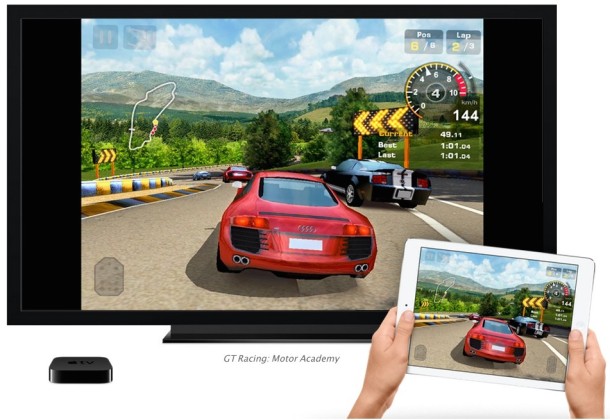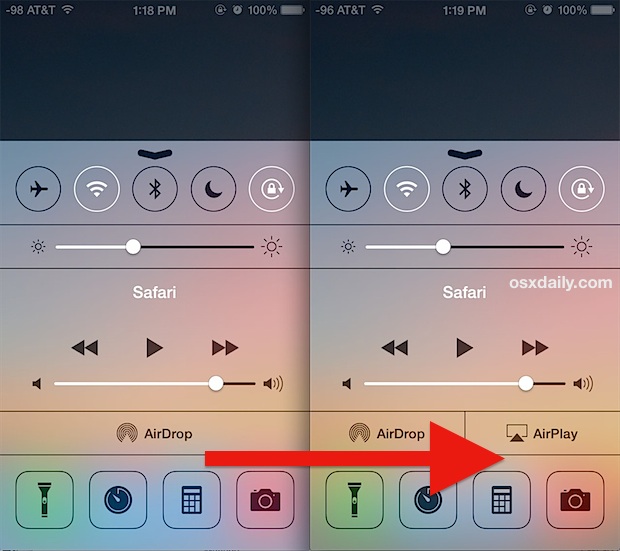
AirPlay Mirroring sends exactly what is on the iPhone or iPad screen wirelessly over to an Apple TV or a compatible AirPlay receiver app on a Mac or PC like Reflector orXBMC, including the audio stream if one is available. This mirroring feature is great for demonstrations, presentations, picture slideshows, watching video on a larger screen, gaming on a bigger display, recording an iOS device screen, and so much more.
AirPlay Mirroring Requirements for iOS
- An AirPlay receiver / server – this can be an Apple TV,Reflector, or XBMC, etc
- The iPhone, iPad, or iPod touch must be new enough to support AirPlay Mirroring, running iOS 7 or newer
- Both the sending iOS device and the receiving AirPlay device must be on the same wi-fi network
Assuming you meet those basic requirements, you can get started streaming the iOS screen over to a bigger display.
How to Use AirPlay Mirroring in iOS 7+
Before doing anything else, be sure the iPhone, iPad, iPod touch is on the same wireless network as the AirPlay receiver, this is necessary otherwise the two devices won’t be able to communicate with one another.
- Power on the Apple TV, or launch the AirPlay Receiver app on a computer
- Swipe up from the bottom of the iOS screen to bring up Control Center
- Tap the “AirPlay” button
- Choose the name of the AirPlay receiver device from the menu, then toggle “Mirroring” to ON to send the iOS screen to the receiver

The iPhone, iPad, or iPod touch screen will now instantly appear on the Apple TV, or the Mac or PC if they are running an AirPlay receiver app.
Using an iPhone mirrored over to a Mac running the Reflector app as an example, this is what it will look like:
It’s important to note that the AirPlay option will not be available if the receiver device is not found. Thus, if “AirPlay” is not visible in Control Center be sure the AirPlay receiver is online and active (meaning, if it’s an app that the app is open and running on the computer), and double-check that both AirPlay streaming devices are on the same wireless network.

These are the two most significant errors encountered with using AirPlay and AirPlay Mirroring in iOS, and fortunately are extremely simple to resolve. If you find that only audio is streaming over and there is no screen display showing up on the receiver device, you probably simply forgot to toggle the “Mirroring” option ON from the Control Center, so just swipe up again and enable it as described in step 4 above.
Sending an iPhone or iPad display mirrored over to an Apple TV will just display the home screen or open app, with the remainder of the TV having black bars. While AirPlay Mirroring is active, the titlebar of iOS will often turn blue to indicate that mirroring is enabled, I say ‘often’ because it doesn’t happen all the time with all devices, thus it’s not reliable enough to be a guaranteed indicator of AirPlay activity.
As of now, Apple only supports AirPlay Mirroring output to an Apple TV, but if you don’t have an Apple TV yourself you can still use the feature and try it out yourself by utilizing third party apps that run in OS X, Linux, or Windows, like the aforementioned Reflector, or XBMC. The latter app is free, whereas the other two options are paid with free trials, all of which make for excellent apps that are well worth exploring for those interested in wireless streaming of the screen of an iPhone, iPad, or iPod touch.
Turning Off AirPlay Mirroring in iOS
Finished mirroring the iOS screen to another display? Disabling AirPlay Mirroring is super simple:
- Flip up from the bottom of the screen to open Control Center again
- Tap on the ‘AirPlay’ button (it should be in white) and select the devices name from the list (for example, iPhone or iPad)
- Tap “Done” to close out both the AirPLay and the mirrored stream instantly
Simply swiping the “Mirror” option to OFF will turn off the display while keeping the AirPlay audio stream active, thus you’ll want to tap onto the device name to turn off the entire feature.
Of course, the AirPlay streaming feature isn’t limited to mirroring, and the same technology can also be used tostream music and much more.
mirroring to Macs, not iOS devices.

No comments:
Post a Comment